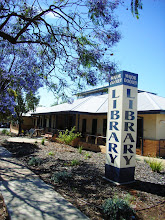The library currently has a number of sets of bookends on display - with many thanks to those who have kindly loaned them to us for a time. Everyone is welcome to come and have a look.
What is it about bookends that appeals to us? What do we know about bookends? Here are some things about bookends you may not know -
A bookend is one of the simplest and most decorative machines invented, with a base and an upright, its weight intended to create a force to resist movement.
Just before last Christmas American artist Jeff Koons, famous for his shiny animal sculptures sent cease and desist letters to San Francisco art gallery and store, Park Life, because they were selling balloon-shaped animal bookends.
Bookends emerged as household objects in the 1870s, when books became cheap enough to be bought by the emerging middle class.
After World War II, aluminium, a product of aircraft technology, was widely recycled for bookends. This was also the peak period for ceramic bookends.
There is a theory that the popularity of Penguin paperbacks in the 1930s inspired a fad for smaller, lighter bookends.
Specific bookend collectors may place sentimental value on something kitsch, such as a pair of Mexicans sleeping under sombreros or some dancing penguins, two of the more popular themes in Australia during the 1950s and '60s.
A pair of actual saltwater crocodile heads, mouths wide open, transformed into a spectacular pair of bookends were sold in Darwin in the 1970s.
In Adelaide an enterprising gentleman engaged a modeller to make plaster masks of himself and his wife which were mounted on highly polished wood plinths for use as bookends.
Mulga wood bookends were often the preferred gift for visitors to Australia and there are numerous reports of Ambassadors and other officials receiving bookends on their departure.
In 1929, “Booklovers”, an American talkie, told the story of two carved bookends coming to life.
A theft of bookends in Tasmania made the local papers when a man was convicted and fined five pounds for stealing, along with other items, a pair of bookends.
Chameleon like in nature, bookends take many forms including, fictional characters, writers, composers, clowns, children, elephants, dogs, lions, galleons, globes and even books.
With no recommended height bookends vary in size and are found in metal, stone, marble, wood, glass, ceramic, bakelite, plaster, plastic and resin. Chryselephantine and chrome indicate the Art Deco period while pressed wood was popular in the 1940s and Mulga wood was popular in Australia from the late 1920s to the 1970s.
In 1932 The Brisbane Courier reported bookends had taken over from toast racks as the most popular wedding gift.
Wednesday, July 6, 2011
Subscribe to:
Post Comments (Atom)

No comments:
Post a Comment